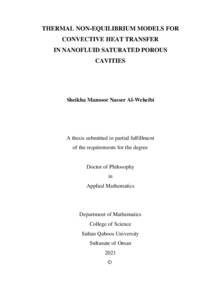Document
Thermal non-equilibrium models for convective heat transfer in nanofluid saturated porous cavities.
Other titles
نماذج حرارية غير متوازنة لنقل الحرارة بالحمل الحراري في تجاويف مسامية مشبعة بالسائل النانوي
Publisher
Sultan Qaboos University.
Gregorian
2021
Language
English
Subject
English abstract
In this dissertation, we numerically studied the unsteady natural convective nanofluid
flows within a two-dimensional right-trapezoidal cavity and a three-dimensional
right-trapezoidal cuboid. The enclosures are filled with various porous mediums such
as aluminum foam (AF), glass ball or glass bead (GB), and sandstone (ST). Different
nanofluids considering various nanoparticles and base-fluids are used for simulation
purposes. The fundamentals of nanofluids and their applications in numerous fields
of science and engineering, the preparation process of nanofluids, and basic
nanofluid flow mechanics in porous media are discussed in detail at the beginning of
the study. To identify the regulating model parameters, a group of transformations of
variables is utilized to make the governing nonlinear and coupled partial differential
equations dimensionless. These equations are then numerically solved using the
COMSOL Multiphysics software, which employs the Galerkin weighted residual
scheme of finite element method.
We investigated four different physical models in depth. The first three are
considered within a two-dimensional right-angle trapezoidal enclosure, while the
fourth one a three-dimensional right trapezoidal cuboid. In our investigation, we
treated the nanofluid as a homogeneous mixture and flows through the porous
medium following the non-Darcy model. For energy transport, two and three energy
equations we considered for the model construction. The porosity and permeability
of the porous medium are considered uniform as well as variable. The impacts of the
controlling model parameters on the flow and thermal fields: Rayleigh number, the
volume fraction of the nanoparticles, the Darcy number, the porosity of the porous
medium, the Nield numbers, bead size creating the porous medium, different aspect
ratios of the cavity, have been investigated. The local thermal non-equilibrium
conditions between the nanofluid and the solid matrix are analyzed. The simulated
results have been presented in terms of streamlines, isotherms, temperature profiles,
and the average Nusselt number to determine the best heat transfer nanofluid in a
porous medium.
The results show that Nield and Darcy's numbers substantially influence the heat
exchange between the nanofluid and the porous matrix. The critical Rayleigh number
for the onset of the local thermal non-equilibrium (LTNE) state between the
nanofluid and the solid matrix having variable porosity and permeability increases as
the Nield number increases. It decreases as the diameter of the beads forming the
porous medium and the porosity parameter increase, whereas the nanoparticle
volume fraction does not affect the critical Rayleigh number.
The heat transfer rate in a nanofluid-filled porous media with variable porosity is
higher when compared to the uniform porosity of the media. Using Glass balls as a
porous matrix raises the average Nusselt numbers of the nanofluid and solid matrix
compared to the other porous matrixes tested. The copper-water nanofluid exhibits
the highest average Nusselt numbers for base fluid, nanoparticles, and porous matrix
compared to the other two examined types of nanofluids. Increased Rayleigh number
and the diameter of the balls constructing the porous medium enhanced the average
Nusselt numbers of the nanofluid and porous matrix. The average Nusselt numbers
of base fluid and nanoparticles increase with the increase of the porosity parameter.
The Nield numbers significantly affect the heat transfer in the base fluid, solid
nanoparticles, and the porous matrix. The aspect ratios of the cavity played a vital
role in heat transfer in all mediums. The trapezoidal cuboid exhibits the highest rate
of heat transfer in the base fluid, nanoparticles, and solid matrix compared with the
cube and the rectangular cuboid.
Member of
Resource URL
Arabic abstract
في هذه الرسالة ، درس الباحث انتقال الحرارة بالحمل الطبيعي غير المستقر في تجاويف مسامية مشبعة بالسائل النانوي ثنائية وثلاثية الأبعاد. تبحث هذه الاطروحة في أربعة نماذج فيزيائية مختلفة بتعمق. الثلاثة الأولى ضمن حاوية شبه منحرف ثنائية الأبعاد بزاوية قائمة بينما الرابع ضمن شبه منحرف ثلاثي الأبعاد.
Category
Theses and Dissertations

